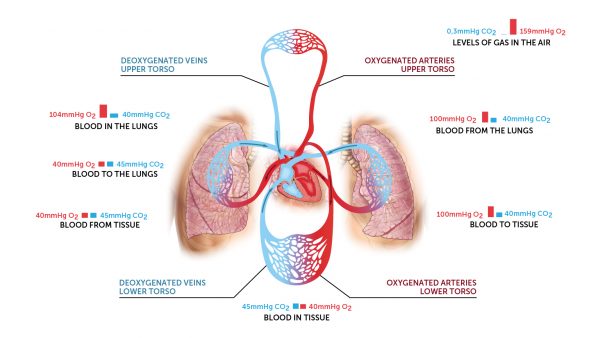Based on the fact that the air in the lungs is only refreshed for each breath, and that the oxygen (O2) and carbon dioxide (CO2) are diffusing from the alveoli and blood respectively (see below), the gas composition in the alveoli is not identical to the air surrounding us (Fig. 10).
- In the air pO2 is approximately 159 mmHg and pCO2 0.3 mmHg.
- In the alveoli the pO2 is approximately 104 mmHg and pCO2 approximately 40 mmHg.
Blood arriving at the alveoli has a pO2 of about 40 mm Hg (Fig. 10). This means there is a much higher oxygen pressure in the alveoli than in the blood. Therefore O2 diffuses from the alveoli into the blood down the pressure gradient from high to low concentration until the pressures are equal to 104 mmHg. The diffusion takes about 0.25 seconds. This corresponds to approximately one third of the time the blood is in the capillaries in normal, resting conditions. This therefore means that the blood velocity can increase three times, and the blood will still be in the capillaries for long enough for the maximum amount of O2 to diffuse across from the lungs.
In the body’s various tissues pO2 will be approximately 40 mmHg due to continuous consumption in the mitochondria. In other words, the oxygen diffuse from the blood into the tissues, whereas when the blood leaves the tissue pO2 is back to about 40 mmHg.
The partial pressure of carbon dioxide in the alveoli is about 40 mmHg (Fig. 10). In venous blood pCO2 is about 45 mmHg. This means that CO2 diffuses from the blood into the alveoli and that pCO2 in the blood leaving the lungs is 40 mmHg. In the various tissues CO2 is produced as a by-product of metabolism and energy (ATP) production.Therefore the PCO2 in the tissues is 45 mmHg. Thus, CO2 diffuses into the blood down the pressure gradient where pCO2 is lower (about 40 mmHg).




